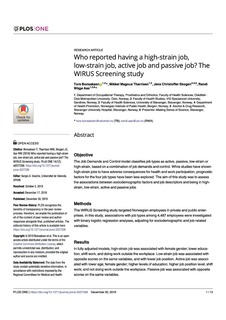Who reported having a high-strain job, low strain job, active job and passive job? The WIRUS screening study
Journal article, Peer reviewed
Published version
Permanent lenke
http://hdl.handle.net/11250/2634813Utgivelsesdato
2019Metadata
Vis full innførselSamlinger
- Artikler / Articles [1186]
- Publikasjoner fra CRIStin [1133]
Sammendrag
Objective: The Job Demands and Control model classifies job types as active, passive, low-strain or high-strain, based on a combination of job demands and control. While studies have shown high-strain jobs to have adverse consequences for health and work participation, prognostic factors for the four job types have been less explored. The aim of this study was to assess the associations between sociodemographic factors and job descriptors and being in high-strain, low-strain, active and passive jobs.
Methods: The WIRUS Screening study targeted Norwegian employees in private and public enterprises. In this study, associations with job types among 4,487 employees were investigated with binary logistic regression analyses, adjusting for sociodemographic and job-related variables.
Results: In fully adjusted models, high-strain job was associated with female gender; lower education; shift work; and doing work outside the workplace. Low-strain job was associated with opposite scores on the same variables, and with lower job position. Active job was associated with lower age; female gender; higher levels of education; higher job position level; shift work; and not doing work outside the workplace. Passive job was associated with opposite scores on the same variables.
Conclusions: The study corroborates the role gender and education have for experiencing the job, and expands on existing knowledge on the role of job position and irregular working hours and spaces. By identifying factors associated with job types, the prevention of health problems and work disability may become be more targeted.
